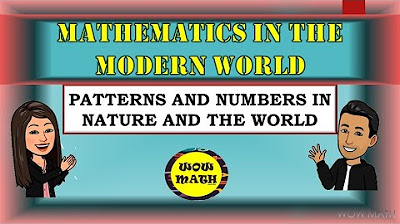P2- Fibonacci Sequence | Golden Ratio | Patterns and Numbers in Nature | Math1/GE3
Summary
TLDRIn this educational video, Teacher Juice explores patterns and numbers found in nature, illustrating how they can be mathematically represented. From snail shells to honeycombs, patterns like spirals, tessellations, and symmetry are discussed. The Fibonacci sequence, with its prevalence in nature and art, is highlighted, along with the Golden Ratio, which is approximately 1.618. The video connects these mathematical concepts to their presence in architecture and nature, emphasizing their significance in our world.
Takeaways
- 🔍 Patterns in nature are regular, repeated forms or designs that help us organize information and understand the world around us.
- 🐌 Examples of natural patterns include the spirals found in snail shells, pine cones, and the Milky Way galaxy.
- 🧩 Tessellations are patterns where shapes fit perfectly together without overlaps or gaps, like honeycombs or floor tiles.
- 🦓 Spots and stripes on animals are patterns that result from reaction-diffusion processes.
- 🪴 Symmetry, such as reflection or mirror symmetry, is a pattern where one part of an object is the mirror image of another.
- 🌼 The Fibonacci sequence is a series of numbers where each number is the sum of the two preceding ones, starting from 0 and 1.
- 🌺 The Fibonacci sequence is often observed in the number of petals in flowers and other natural phenomena.
- 🔢 The golden ratio, approximately 1.618, is derived from the Fibonacci sequence and is found in various aspects of art, architecture, and nature.
- 🏛 Famous structures like the Parthenon, Taj Mahal, and Egyptian pyramids incorporate the golden ratio in their design.
- 🌈 The Fibonacci spiral, created by connecting squares of Fibonacci numbers, is a visual representation of the sequence and is found in various natural forms.
Q & A
What is a pattern according to the video?
-A pattern is defined as a regular, repeated, or recurring form or design, especially in the natural world.
Why are patterns in nature important?
-Patterns in nature help us organize information and make sense of the world around us.
What are the steps to follow to understand math in the context of patterns?
-The steps are: 1) to find a pattern, 2) represent patterns in the form of symbols, notations, shapes, or numbers, and 3) interpret the pattern.
What is an example of a pattern in the video?
-An example given is the blue lines progressively getting thicker until they would take over the whole square.
How are missing terms in a sequence determined in the video?
-The missing terms are determined by identifying the pattern in the sequence, such as adding 4 to the preceding number to find the next term.
What are the different types of patterns found in nature mentioned in the video?
-The types of patterns include spirals, tessellations, spots and stripes, and symmetry.
Can you explain what a spiral pattern is as described in the video?
-A spiral pattern is curved and starts from a small point, moving farther away as it revolves, getting bigger but maintaining the same pattern.
What is tessellation and how is it related to patterns in nature?
-Tessellation is a pattern of shapes that fit perfectly together without overlaps or gaps, like honeycombs or floor tiles.
How are spots and stripes patterns formed in animals?
-Spots and stripes patterns in animals are the result of a reaction-diffusion process.
What is symmetry and how does it relate to patterns?
-Symmetry means that one shape becomes exactly like another shape when moved in some ways, indicating that parts of an object are mirror images of each other.
What is the Fibonacci sequence and how is it related to patterns in nature?
-The Fibonacci sequence is a series of numbers where each number is the sum of the two preceding ones, starting from 0 and 1. It is often found in patterns in nature, such as the number of petals in a flower.
How is the golden ratio derived from the Fibonacci sequence?
-The golden ratio is derived by dividing two consecutive Fibonacci numbers, and it is approximately equal to 1.618.
Why is the golden ratio significant in art, architecture, and design?
-The golden ratio is significant because it is considered aesthetically pleasing and is found in many famous architectural structures and works of art.
Outlines

Этот раздел доступен только подписчикам платных тарифов. Пожалуйста, перейдите на платный тариф для доступа.
Перейти на платный тарифMindmap

Этот раздел доступен только подписчикам платных тарифов. Пожалуйста, перейдите на платный тариф для доступа.
Перейти на платный тарифKeywords

Этот раздел доступен только подписчикам платных тарифов. Пожалуйста, перейдите на платный тариф для доступа.
Перейти на платный тарифHighlights

Этот раздел доступен только подписчикам платных тарифов. Пожалуйста, перейдите на платный тариф для доступа.
Перейти на платный тарифTranscripts

Этот раздел доступен только подписчикам платных тарифов. Пожалуйста, перейдите на платный тариф для доступа.
Перейти на платный тарифПосмотреть больше похожих видео

PART 1: PATTERNS AND NUMBERS IN NATURE AND THE WORLD || MATHEMATICS IN THE MODERN WORLD

RATIONAL NUMBERS | FIRST QUARTER GRADE 7 MATATAG TAGALOG MATH TUTORIAL

Materi Polinomial kelas XI MIPA Matematika Peminatan Pertemuan 1- PPL 2 PPG Prajabatan Gel 1

[Video Edukasi] Tematik Kelas 1 : Pola Bilangan

79. OCR A Level (H046-H446) SLR13 - 1.4 Floating point binary part 1 - Overview

Introduction to Cycles, Periods, and Periodic Functions - Nerdstudy
5.0 / 5 (0 votes)
